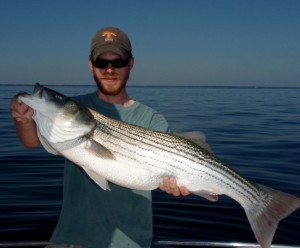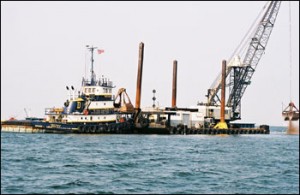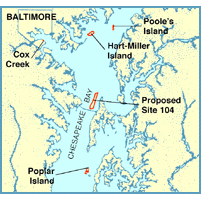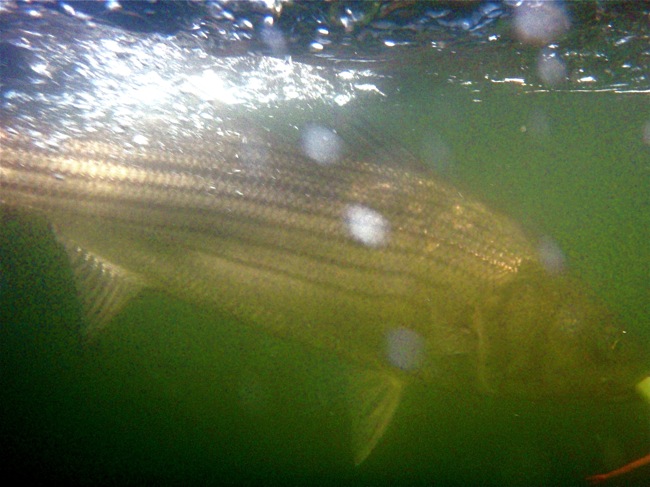 I like to think I have a pretty good arsenal of fishing spots around Kent Island, but If you’d asked me a few weeks ago to point to Site 104 on a Chesapeake chart, I couldn’t have. In fact, until recently I’d never heard of the place or the environmental controversy that once swirled around it. I’ve just been going about my merry way, fishing when I can and fortunately finding success at one of my favorite locations in the Upper Bay. I now know that fishing spot has an interesting history, and I realize I have some people to thank for the exceptional spring fishing of 2010. If not for their work a decade ago, the place would be completely silted over.
I like to think I have a pretty good arsenal of fishing spots around Kent Island, but If you’d asked me a few weeks ago to point to Site 104 on a Chesapeake chart, I couldn’t have. In fact, until recently I’d never heard of the place or the environmental controversy that once swirled around it. I’ve just been going about my merry way, fishing when I can and fortunately finding success at one of my favorite locations in the Upper Bay. I now know that fishing spot has an interesting history, and I realize I have some people to thank for the exceptional spring fishing of 2010. If not for their work a decade ago, the place would be completely silted over.
I started fishing Site 104 when I first moved to this area in 2006. Underwater structure on live-bottoms along steep ledges is hard to find in the Chesapeake. Fishing out of my home base which was then on the Magothy River, I recognized early on that this was an easily accessible area likely to hold fish. The following spring I got a phone call from my new friend Steve Fogle of Backyard Custom Rods. He gave me a report of big fish at a specific location close to this place I was fishing. His hotspot turned out to be a narrow strip of underwater humps along the ancient Susquehanna river channel. Some of the humps were littered with blocks and boulders. Like Steve, I found the area extremely productive and began fishing it regularly in 2007.
 I have Site 104 marked in my fishing journal as a good post-spawn location. By that, I mean I start fishing there in the spring when I think the fish are moving out of the rivers and pausing to feed before they migrate out of the Bay and on up the coast to New England. In recent years my opinion has changed. I now think Site 104 is a stopping place for three and four year old fish who haven’t quite figured out the spawning routine. I think it holds a mix of resident and migratory fish, some carrying eggs, who stall out on their way to the spawning grounds. Most of the fish are in the twenty-five to thirty inch range. It’s unusual to get one over thirty-five inches long here. They’re next year’s spawning class. The future of the Chesapeake striper population.
I have Site 104 marked in my fishing journal as a good post-spawn location. By that, I mean I start fishing there in the spring when I think the fish are moving out of the rivers and pausing to feed before they migrate out of the Bay and on up the coast to New England. In recent years my opinion has changed. I now think Site 104 is a stopping place for three and four year old fish who haven’t quite figured out the spawning routine. I think it holds a mix of resident and migratory fish, some carrying eggs, who stall out on their way to the spawning grounds. Most of the fish are in the twenty-five to thirty inch range. It’s unusual to get one over thirty-five inches long here. They’re next year’s spawning class. The future of the Chesapeake striper population.
In 1999, Site 104 was in trouble. The Army Corps of Engineers, along with the Baltimore Port Authority needed a convenient place to dump dredged sediments from the bottom of the shipping channel. The site they dubbed “104” seemed like the logical place. It had been used as a dumping ground for hundreds of years. The bottom is littered with rocks and other debris, some probably dating back to the 17th century as early explorers dumped their ship’s ballast in this area before entering the shallow rivers of the Upper Bay. It had even been used to dump dredged material in the 20th century up until about 1978.
Ten years ago the Chesapeake was in even worse shape than it is now. The ecosystem had started to rebound from the dark decades of the 70s and 80s, but there was (and still is) a long way to go. When the Army Corps released an environmental impact statement drastically minimizing their plan to dump 18 million cubic yards of toxic sludge from the bottom of the Baltimore channel into the open waters of the Bay, Marylanders took exception.
 Thanks to the work of environmental groups and concerned individuals, educational efforts and policies aimed at keeping silt out of the Bay were catching on. Scientists reported that stored-up nutrients and contaminants from the dredged channels would cover bottom-dwelling organisms and wipe out rebounding underwater grasses. Citizens were outraged at the idea of dumping dredged material into open waters. In 1999, Columnist Eric Smith, of the Annapolis Capital, argued that an ordinary citizen would be heavily fined for dumping even a small amount of dirt into the Bay, while the Corps of Engineers and the Maryland Port Authority might be allowed to dump millions of cubic yards of dredged material in the middle of the estuary. To many, the idea of taking dredged sediment from one part of the Bay and dumping it in another seemed just plain wrong (1).
Thanks to the work of environmental groups and concerned individuals, educational efforts and policies aimed at keeping silt out of the Bay were catching on. Scientists reported that stored-up nutrients and contaminants from the dredged channels would cover bottom-dwelling organisms and wipe out rebounding underwater grasses. Citizens were outraged at the idea of dumping dredged material into open waters. In 1999, Columnist Eric Smith, of the Annapolis Capital, argued that an ordinary citizen would be heavily fined for dumping even a small amount of dirt into the Bay, while the Corps of Engineers and the Maryland Port Authority might be allowed to dump millions of cubic yards of dredged material in the middle of the estuary. To many, the idea of taking dredged sediment from one part of the Bay and dumping it in another seemed just plain wrong (1).
Leading the charge was the Chesapeake Bay Foundation (CBF). Taking issue with the Army Corps of Engineer’s environmental impact statement, the CBF newsletter “Save the Bay” stated bluntly, “The report contains significant flaws and inconsistencies, particularly with regard to nutrient releases and impacts to crab and fish habitat.” Public outrage grew.
Bowing to extreme political pressure, in February of 2001 Maryland port officials banned the dumping of dredged materials in the open Bay. Instead, they agreed to use the sludge to rebuild islands like Hart-Miller, Pooles and Poplar that were slowly eroding away. The Baltimore Sun reported on the celebrations that followed. The group “Citizens Against Open Bay Dumping” held a party on Kent Island where, according to the Sun, they “drank beer and ate a cake decorated with fish while swaying to the song ‘Celebrate.” For once, the people of Maryland and the Chesapeake Bay won.
 I’m happy to report that Site 104 is alive and very well in 2010. It’s teeming with perch, rockfish, croaker, drum, and countless other species. Readers of Chesapeake Light Tackle will recognize Site 104 as “The Land of Giants.” On modern Chesapeake Charts, it’s the upper reaches of the Dumping Grounds, the area just west of Love Point where most of my thirty inch plus rockfish have been caught this spring.
I’m happy to report that Site 104 is alive and very well in 2010. It’s teeming with perch, rockfish, croaker, drum, and countless other species. Readers of Chesapeake Light Tackle will recognize Site 104 as “The Land of Giants.” On modern Chesapeake Charts, it’s the upper reaches of the Dumping Grounds, the area just west of Love Point where most of my thirty inch plus rockfish have been caught this spring.
The fishing has slowed somewhat now, but it’s the place where CBF Senior Naturalist J.P. Williams and I have been taking water quality samples, the area where most of the Upper Bay charter fleet chums and where at least a half dozen black drum have been caught on artificial baits and light tackle in 2010. Simply put, Site 104 is now one of the best fishing spots on the Chesapeake Bay, and we owe it all to some concerned people who took a stand to establish a no-dumping precedent ten years ago. It shows how far we’ve come, and illuminates where we can go, a worthwhile tradition of protecting clean water in the Chesapeake Bay. To those of you who made your voices heard in the 1990s from fishermen who appreciate cleaner water in 2010 – THANKS!
(1) Jack Greer in Maryland Marine Notes, Volume 18, Number 2 • March-April 2000





Great article Shawn!
It was nice to me this spring. I’m grateful as well. Thanks for the history on it.
Mike
Shawn,
Very educational. I wouldn’t put anything past the Corps of Engineers of wreck the Everglades fame, but its amazing what can be changed if people voice their opposition to something. Thanks for writing.
Don
Shawn, Thanks as always for taking your time to try and help us learn how and where to go. Hope I can find site 104 and sea you out there and maybe I will learn something. Thanks again Jim.
Great Read Shawn,sure is a nice fish.
Lets hope the bay will continue to improve,I still believe it has gotten better from what it used to be.
Another terrific write up Shawn, thanks for taking the time…
Shawn,
I’m glad I made the call to you that day because from that day forward we have been very good friends. That spot was hot again this year but only for a few weeks as you know but boy can it hold some nice fish at the right time of year. Thanks for another great read and look forward to hooking up with you very soon, I still need a ride on that boat.
Back in the late ’50s and early ’60s I remember my family lived on the shore. I remember going over the bridge at night and seeing all the lights from the boats fishing the Dumping Grounds. It was like a city.
My first charter trip where I remember was on those grounds. I can actually remember the boats almost being gunwale to gunwale. The captain was mashing clams with a sledge hammer in a bucket for chum.
Glad to see the area is still doing well.